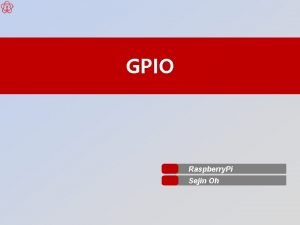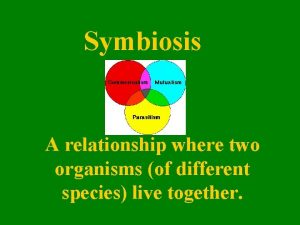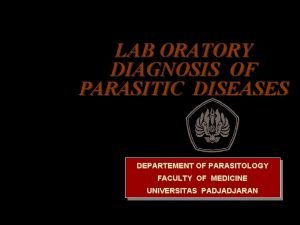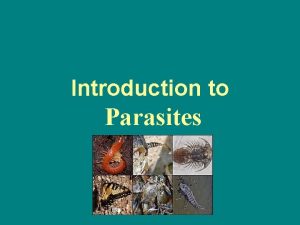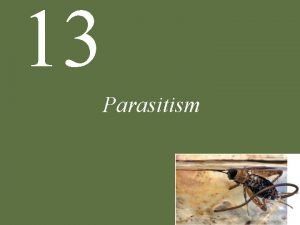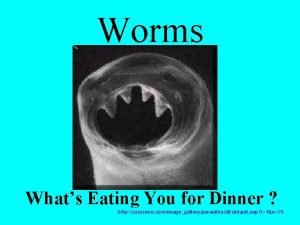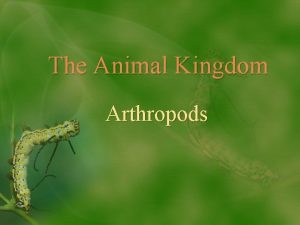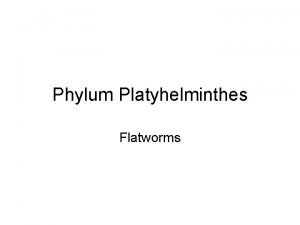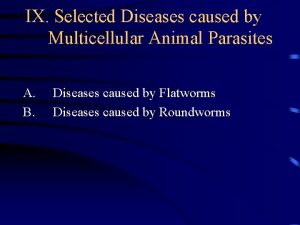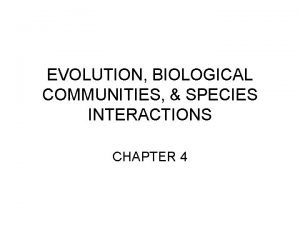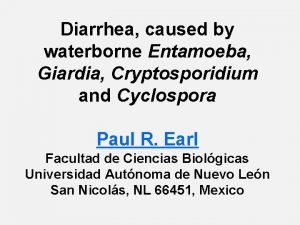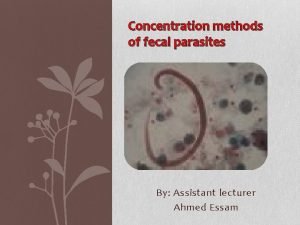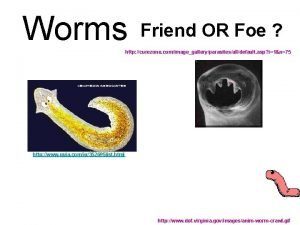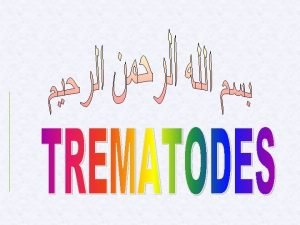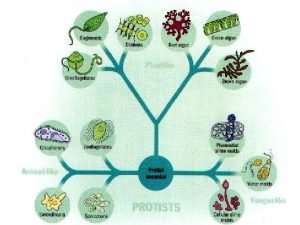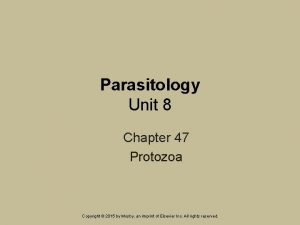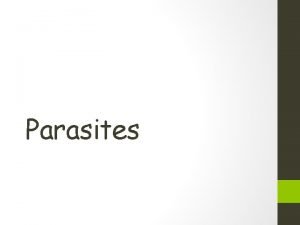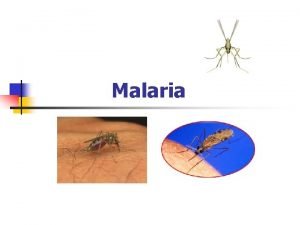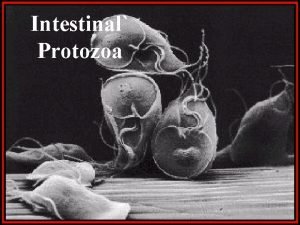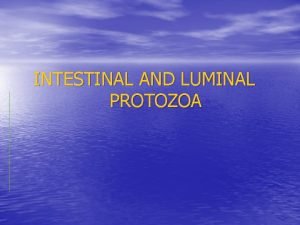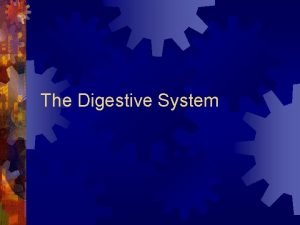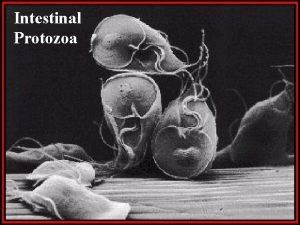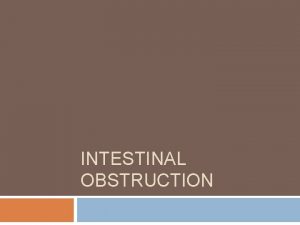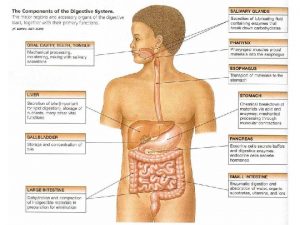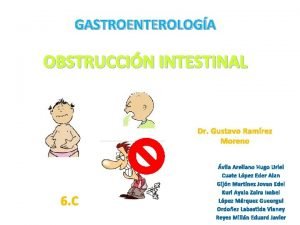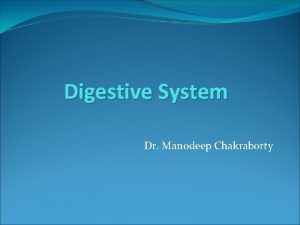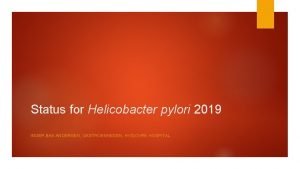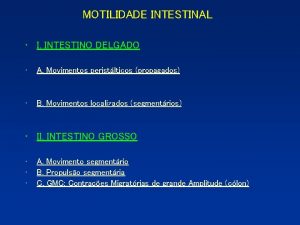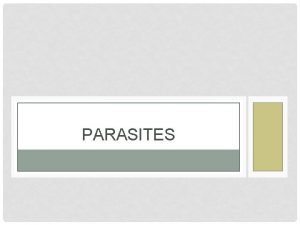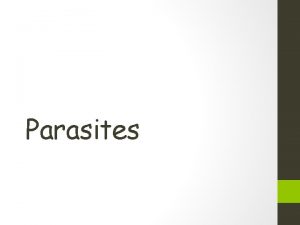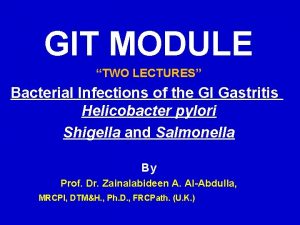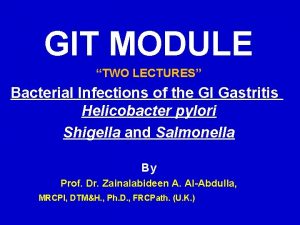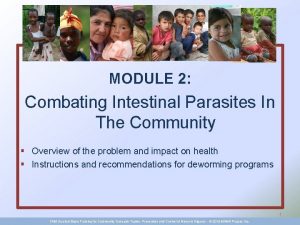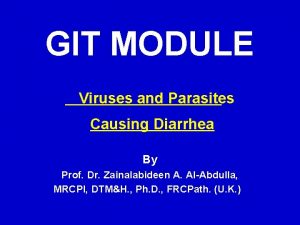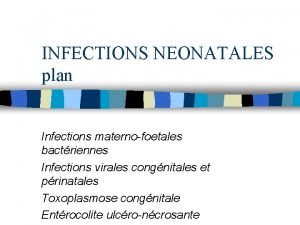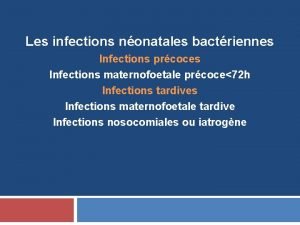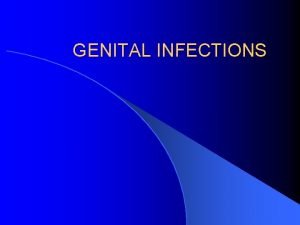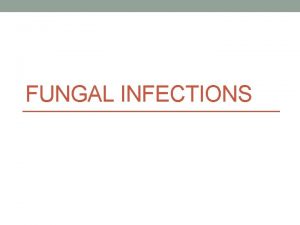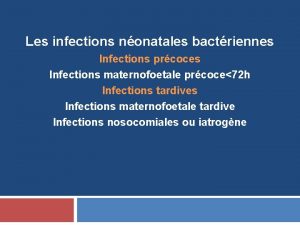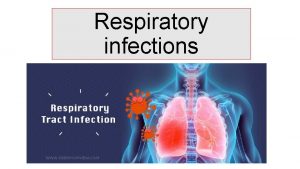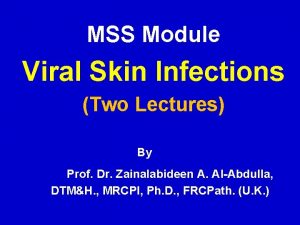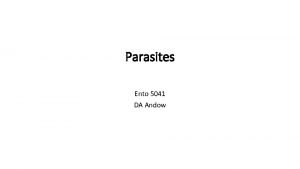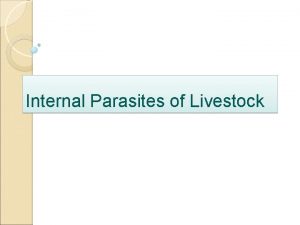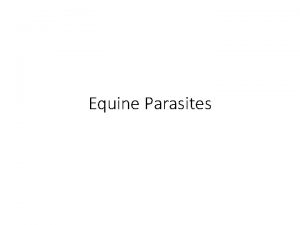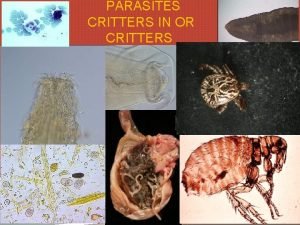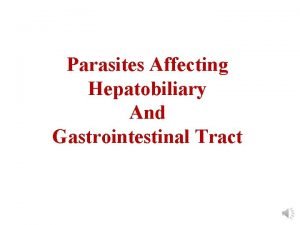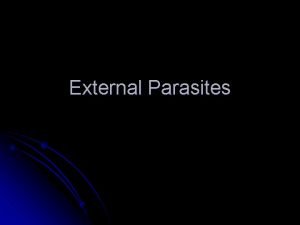GIT MODULE Intestinal Infections with Parasites Two Lectures




















































- Slides: 52

GIT MODULE Intestinal Infections with Parasites (Two Lectures) By Prof. Dr. Zainalabideen A. Al-Abdulla, MRCPI, DTM&H. , Ph. D. , FRCPath. (U. K. )

Learning objectives 1. Understand infection arising from Nematodes: Enterobius, Trichuris, Ascaris, Ancylostoma, Necator, Strongyloides, and Toxocara. 2. Understand infections caused by Cestodes: Taenia, and Hymenolepis nana, as well as: - Trematode: Fasciola 3. Recognize the life cycle, morphology, laboratory diagnosis, epidemiology, immunity, and treatment for each parasite.

Intestinal Nematodes Cylindrical, tapered bodies, and covered with cuticles; infect > 25% of human race: 1. Enterobius vermicularis (pinworm) 2. Trichuris trichiura (whipworm) 3. Ascaris lumbricoides (large roundworm) 4. Necator americanus (hookworm) 5. Ancylostoma duodenale (hookworm) 6. Strongyloides stercolaris



Enterobius vermicularis (Pinworm, Threadworm; Disease: Enterobiasis) Life cycle • Adults (male & female): Inhabit colon/caecum • Female transits anus at night to deposit eggs (sticky/resistant) on perineum; causing itching • Eggs infectious to host and others shortly; Ingested eggs hatch and larvae mature to adults in intestine in 1 month; adults live 2 months.




Manifestations - Nocturnal pruritus ani - Females: Genito-urinary infection Diagnosis - Perianal cellophane tape test (for ova) Treatment - Pyrantel pamoate - Mebendazole • All members of the family; repeat in 2 weeks

Trichuris trichiura (whipworm) - Anterior 2/3 thread-like (whip-like) - Tail: Male coiled; Female straight Life cycle - Attach by anterior end to colonic mucosa - Adults inhabit caecum and release eggs - Eggs mature in soil & become infective in 15 to 30 days (may be shorter). - Ingested eggs, hatch in duodenum, larvae released; mature at small intestine in 1 month; migrate to cecum and ascending colon.




Epidemiology - Associated with defecation on soil and warm, humid climate - Adult worms may live for years usually for 1 year, but may extend to 4 - 8 Y) Pathogenesis & immunity - Local ulceration and hemorrhage (5 µl/worm/ day causing anemia); leading also to bacteremia - CMI and Ig. E-mediated mucosal immunity


Manifestations - Anemia, and “dysentery syndrome” due to colonic damage causing pain and diarrhea - Colonic or rectal prolapse in heavy worm load Diagnosis - Stool examination for eggs (low power lens) - Eosinophilia Treatment - Mebendazole (drug of choice), Albendazole - Cure rate 60 -70%; Prevention: Good sanitation

Ascaris lumbricoides - Short-lived (6 -18 months); most common, - 15 -40 cm in length. Life cycle See the Figure Pathogenesis & Immunity - Partially protective immunity - Pulmonary immediate hypersensitivity to larval migration leading to tissue damage.




Clinical manifestations - Asymptomatic with small worm loads - Respiratory symptoms (larval migration) - Malabsorption and occasional intestinal obstruction with heavy worm load


Diagnosis - Stool examination for eggs - Sputum: Larvae and eosinophils (pulmonary phase) Treatment - Albendazole, Mebendazole, Pyrantel Pamoate - Community mass-therapy; at 6 months intervals can be repeated.

Hookworms (Ancylostoma duodenale and Necator americanus) - Pinkish-white, 10 mm, head curved (hooked) - Species differ by morphology of oral cavity: • A. duodenale: 4 sharp tooth-like • N. americanus: Dorsal/ventral cutting plates Life cycle: See Figure - Eggs: 4 - 8 celled




Epidemiology - Worldwide; Limited to tropical areas mainly - Larvae require hot, moist conditions Pathogenesis and Immunity - Blood loss: Significant (Iron deficiency Anemia) A. duodenale = 0. 2 ml/day N. americanus= 0. 03 ml/day - Adults live 2 -14 Y in the gut - Eosinophilia: Gut and blood - Humoral immunity and immediate hypersensitivity

Manifestations - Asymptomatic mostly - Pruritus and rash at skin penetration - IDA due to intestinal blood loss & complications Diagnosis - Stool examination for eggs Treatment and prevention - Pyrantel pamoate, mebendazole, albendazole - Correct anemia - Sanitation, wearing shoes for prevention

Strongyloides stercoralis - Complex life cycle - 2 mm length (smallest intestinal nematode) - Eggs not important in diagnosis (why? ) - Larvae differ from those of hookworm (how? )


Life cycle 1. Primary cycle resembles hookworm except larvae develop in human gut 2. Filariform stage in gut: Auto-infection 3. Adult develop in soil: Sustained life cycle Epidemiology Similar to hookworm, but less common



Manifestations - Pulmonary and intestinal manifestations can be similar to hookworm and Ascaris infections - External auto-infections causes lesions over buttocks, abdomen, and back - Massive hyper-infection occurs in immunosuppressed patients, but uncommon in AIDS - Strongyloidiasis should be considered before immunosuppression of patients at risk

Diagnosis - Finding rhabditiform larvae in stool or duodenal aspirate - Sputum examination for larvae - Serology (e. g. ELISA) for antibodies may be helpful in subclinical autoinfection

Treatment • Uncomplicated: - Ivermectin: 2 oral doses • Hyper-infection: - Ivermectin: 1 week (extended) 6 m. in immunocompromised • Cure rate: About 100%


Taenia (Cestodes) 1. T. saginata (Beef tapeworm) 2. T. solium (Pork tapeworm) Epidemiology - T saginata: Common in the Middle East - T. solium: Common in the USA/Europe Laboratory diagnosis - Adhesive cellophane tape technique - Stool examination: Detect eggs & proglottids


Tapeworm structures 1. Taenia saginata. 3. Taenia solium. scolices; gravid proglottids; ) ova (indistinguishable between species).

Treatment and Prevention - Praziquantel or Niclosamide: Single dose, oral - Check after 3 months - Sewage disposal, meat inspection, and adequate cooking

Hymenolepis nana - “Dwarf tapeworm”; 4 cm long - Transmitted directly human-to-human - Eggs ingested via fecal-oral route - Embryo released and invade intestinal wall - Re-enter the gut lumen as adult worms - Asymptomatic, or diarrhea, abdominal pain Treatment: As other tape worms

Egg of Hymenolepis nana: Oval with inner membrane of two poles, from which 4 -8 polar filaments spread out between these two membranes.

Fasciola hepatica (sheep liver fluke) - It is a Trematode - Adults survive decades in biliary tract Life cycle: See the Figure Diagnosis: Eggs (Urn-like, knob on the wide pole) in feces and duodenal aspirate Treatment: Praziquantel, and albendazole


Toxocara canis (Dog Round Worm) - Soil contaminated with ova deposited by domestic dogs - Children are often infected - Infection is more common than disease # See Figure for life cycle - “Visceral larva migrans” occurs by migratory larvae in different human tissues.


Visceral larva migrans - Skin rash, enlarged spleen, asthma, pulmonary infiltrate, abdominal pain, sleep & behavioral changes, focal neurological defects, and seizure - Invasion of eyes in older children and adults result in “ocular larva migrans” - Lasts weeks to months & may result in death: • Human dead end host • Larvae migrate to different tissue causing damage and NO adult worm developed

cont. /… Visceral larva migrans” Diagnosis - Tissue biopsy and sero-diagnosis by EIA Treatment and Prevention • Corticosteroid + Albendazole - Disposal of pet feces - Deworming of dogs (every 3 months in first year, then every 6 months) - Avoid geophagia (eating earth or soil)

 Git clone git://git.drogon.net/wiringpi
Git clone git://git.drogon.net/wiringpi Parasitism
Parasitism Opportunistic infections
Opportunistic infections Methotrexate and yeast infections
Methotrexate and yeast infections Opportunistic infections
Opportunistic infections A bacterial std that usually affects mucous membranes
A bacterial std that usually affects mucous membranes Understanding the mirai botnet
Understanding the mirai botnet Storch infections
Storch infections Storch infections
Storch infections Bone and joint infections
Bone and joint infections Neurosiphyllis
Neurosiphyllis Bacterial vaginosis
Bacterial vaginosis Postpartum infections
Postpartum infections Retroviruses and opportunistic infections
Retroviruses and opportunistic infections Genital infections
Genital infections Genital infections
Genital infections Nosocomial infections
Nosocomial infections Classification of acute gingival infections
Classification of acute gingival infections Kato-katz and kato thick procedure
Kato-katz and kato thick procedure Entamoeba histolytica common name
Entamoeba histolytica common name Parasite
Parasite Bacteria virus fungi and parasites
Bacteria virus fungi and parasites Curezone
Curezone Arthropod
Arthropod Flatworms acoelomates
Flatworms acoelomates Parasites alimentaires
Parasites alimentaires Multicellular animal parasites
Multicellular animal parasites Parasites of medical importance
Parasites of medical importance What do parasites eat
What do parasites eat Parasite consumer
Parasite consumer Chromatin
Chromatin Ova cysts and parasites
Ova cysts and parasites Curezone parasites
Curezone parasites Autoinfection parasites examples
Autoinfection parasites examples Are protists polyphyletic
Are protists polyphyletic Sarcomastigophora are unicellular immotile parasites
Sarcomastigophora are unicellular immotile parasites Parasites of livestock - vocabulary
Parasites of livestock - vocabulary Segmented worms symmetry
Segmented worms symmetry Gametocytes of plasmodium
Gametocytes of plasmodium Classification of parasites
Classification of parasites Mastigophora examples
Mastigophora examples Enslaver parasites
Enslaver parasites Bankers are parasites
Bankers are parasites C device module module 1
C device module module 1 Plicae digestive system
Plicae digestive system Giadriasis
Giadriasis Classification of duodenal atresia
Classification of duodenal atresia Layers of the intestinal wall
Layers of the intestinal wall Porraceo
Porraceo Ts of liver
Ts of liver Cephalic phase of digestion
Cephalic phase of digestion Intestinal metaplasi ventrikel
Intestinal metaplasi ventrikel Motilidade intestinal
Motilidade intestinal
